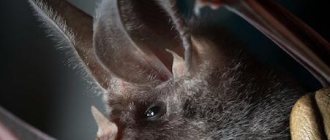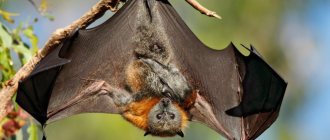№1
Do you know how many species of bats there are in the world? Many people think that there are only a few. In fact, there are about 1,100 species. They can be found in almost every corner of our planet, with the exception of extreme deserts and polar regions. They can be of different sizes and different shapes. For example, the species Craseonycteris thonglongyai, also known as the pig-nosed bat, is the smallest representative. Its body weight does not exceed 2 grams. In contrast, the giant flying fox (Pteropus vampyrus) is one of the largest species. The length of its body can reach 40 cm, and its weight is 1100 grams.
Chiropteran habitats
These animals, which amaze with their unusual and terrifying appearance, live throughout the planet except the Arctic and Antarctica.
Horseshoe bats
This type is considered the most common. It can be found in many European countries where there is a temperate climate. There are about 50 species here.
They are called horseshoe bats because of their horseshoe-shaped nose.
Noctules These bats are also quite common and have about 70 species. Among the many species, only one species spreads beyond the Arctic Circle.
Noctule - because it flies exclusively at night
№3
Despite their small size, they have virtually no natural predators. The greatest danger to their health is the so-called disease “white nose syndrome”. This disease kills millions of bats every year. The disease is caused by a fungus that attacks the wings and face of animals when they are in a state of hibernation.
Ultrasonic signals for navigation in space
To navigate dark caves and hunt after dark, microbats rely on echolocation, a system that allows them to detect objects using sound waves. They echolocate by producing a high-pitched sound that travels until it hits an object and is reflected back to them. The echo gives them data about the size of the object and the distance to it.
Unlike microbats, large bats live in the tropics and eat fruit, nectar and pollen. They have large eyes and a strong sense of smell, but their ears are smaller because they do not echolocate.
№8
Just like cats, they clean themselves. They are far from being dirty creatures, as many might think. They spend quite a lot of time maintaining personal hygiene. Some species even groom each other. In addition to cleansing your body of dirt, such cleansing helps fight parasites.
№9
They use echolocation to navigate in the dark. They have fairly poor eyesight and, moreover, are active almost all the time in the dark. Therefore, they have to rely not on their vision, but on navigation methods. Bats send out sound signals and listen for changes in echoes that bounce off objects and come back.
There are two main types of bats
Bats are divided into microbats (Microchiroptera) and megabats (Megachiroptera). The former can weigh less than a coin, while the latter have a wingspan that can reach 1.5 meters!
Photo: James Wainscoat
Most bats are microbats that eat nocturnal insects such as moths. Vampire bats are the only microbats that feed on blood rather than insects. But don't worry - they prefer to drink the blood of cattle rather than humans.
№10
Almost all species hang upside down. Bats have very developed legs, which help them stay in a relaxed state even when they are tense. However, not all species sleep and rest in this position. There are six species of bats that rest without hanging upside down. These species have suckers on their limbs that help them stick to leaves and other surfaces.
Conservationists with global influence
Despite all the misconceptions about bats, they are very important to humans and the environment. The insectivorous microbats consume millions of beetles at night, acting as a natural pest fighter. Thanks to bats, farmers can rely less on toxic pesticides that cost them millions of dollars each year.
Photo: Zdeněk Machaček
Nectar-drinking bats pollinate plants so they can bear fruit. More than 500 plant species, including mangoes, bananas and avocados, depend on bat pollination. Finally, fruit eaters disperse seeds throughout the rainforest, helping to mitigate the effects of widespread deforestation.
№11
Bracken Cave, located in Texas (USA), is home to the largest colony of bats in the world. There are about 20 million individuals living there, almost equal to the number of inhabitants of Shanghai, the most populous city in the world.
When the bats leave the cave, their flock is so large that it appears on radar as a huge storm. In just one night they eat about 200 tons of beetles.
Bats roost everywhere
Roosts are places where bats rest. They usually choose cracks in the rocks for them, which hide and protect them. The most common settlements are existing structures such as caves, hollow trees, and old buildings.
Photo: JASON CORBETT
The seasons often dictate where bats choose to live. For example, in winter some individuals hibernate in caves, and in summer they return to the attics of abandoned buildings. Because good roosting sites can be difficult to find, many individuals live in giant colonies with millions of other bats.
Bracken Cave is the world's largest bat colony. It is located near San Antonio. From March to October it is home to a population of 20 million Mexican bats.
№13
There are two main groups: Megachiroptera (bats) and Microchiroptera (bats). Fruit bats are also known as fruit bats and typically live in warm climates. They use their large eyes to search for food in the dark and live in trees rather than in caves. Bats tend to be smaller in size and use echolocation to find insects. Microchiroptera are found throughout the world.
It is also worth noting that there are other differences between Megachiroptera and Microchiroptera. Fruit bats have two claws, while Microchiroptera have only one claw. Also, fruit bats have more developed brains and rely more on their senses (vision and smell) and less on echolocation.
25 interesting facts about bats that you probably didn’t know (26 photos)
Author: sdv
March 28, 2022 10:15
Community: Animals
Tags: wild animals animals interesting interesting facts history bats educational facts
24892
26
Bats have been around for millions of years - they appeared before humans inhabited the planet. Despite their reputation as not-so-cuddly creatures, they are some of the most amazing creatures in the world. But what makes them so interesting?
0
See all photos in the gallery
1. The scientific name of bats, Chiroptera, comes from the Greek words “cheir” (hand) and “pteron” (wing) = “chiroptera”.
0
Source:
2. The word "bat" (from English - bat), appeared in 1570 from the Middle English word "bakke", which is related to the Old Swedish word "natbakka", meaning "night bat", and the Old Norse "leđrblaka" meaning "leather flapper"
×
0
Source:
3. In 600 BC. Greek fabulist Aesop wrote a fable about a bat who borrowed money to start a business. According to the story, the business went bankrupt, and she was forced to hide during the daytime to avoid meeting those to whom she owes money. This is why, according to the fable, bats only appear at night.
0
Source:
4. Bats can be divided into two main groups: 1 - fruit bats, large bats that eat mainly fruits, and common bats that eat insects, frogs, fish, lizards, birds and drink blood.
0
Source:
5. Bats that feed on frogs can distinguish poisonous from non-venomous ones by listening to the sounds made by the male frog.
0
Source:
6. Scientists believe that bats first appeared 65-100 million years ago, at the same time as dinosaurs. The earliest known fruit bats lived thirty-five million years ago. Many scientists believe that fruit bats may be more closely related to primates (including humans) than common bats.
0
Source:
7. In China and Japan, bats are a symbol of happiness. In Chinese, the words "bat" and "luck" are pronounced the same - "fu".
0
Source:
8. The wings of bats consist of phalanges of the fingers of the hand, covered with a skin membrane. This membrane makes up almost 95% of the body surface - it helps bats regulate body temperature, blood pressure, water balance and gas exchange.
0
Source:
9. Bats are the only mammals that can fly. The difference between bats and flying squirrels (other mammals that are mistakenly believed to be able to fly) is that mice can control their flight, while flying squirrels can only glide.
0
Source:
10. Unlike birds, which flap their entire forelimbs when flying, bats actually flap their elongated toes.
0
Source:
11. Scientists used an anticoagulant from the saliva of vampire bats to treat people who had suffered strokes and heart patients.
0
Source:
12. Contrary to popular belief, bats are not blind. Many of them can see quite well, and some species can even detect ultraviolet light.
0
Source:
13. Chiropterans can hear sounds at frequencies from 20 to 120,000 Hz. By comparison, humans can only hear from 20 Hz to 20,000 Hz; dogs - from 40 Hz to 60,000 Hz.
0
Source:
14. Bats are the slowest breeding mammals in the world based on their size. Their pregnancy lasts longer than other animals of the same size.
0
Source:
15. Approximately 70% of bats eat insects. The average bat can eat more than 600 bugs per hour - that's equivalent to the average person eating about twenty pizzas overnight.
0
Source:
16. The story of Count Dracula originated in Eastern Europe, but true vampire bats are only found in Central and South America.
0
Source:
17. Bats live on all continents except Antarctica. They are found as far north as the Arctic Circle and as far south as Argentina and the southernmost point of South Africa.
0
Source:
18. Vampire bats are the only mammals that feed only on blood.
0
Source:
19. Contrary to popular belief, vampire bats do not actually suck blood. They usually "absorb" up to two teaspoons per night. Blood moves through the mouth through two channels located under the animal's tongue. The mice's body uses only red blood cells (erythrocytes), and within two minutes of the start of "absorption", the blood plasma is excreted in the urine.
0
Source:
20. Vampire bats drink an amount of blood equal to their weight every day. By comparison, a human vampire, such as Dracula, would have to drink the blood of an entire table of people every night in order to survive.
0
Source:
21. The world's largest bat creature is the giant flying fox. Its wingspan ranges from 1.5 to 1.8 meters.
0
Source:
22. Bracken Bat Cave in Texas, USA - the largest bat colony in the world. More than 20 million bats live in this cave.
0
Source:
23. According to a study by Animal Planet, vampire bats are the third most dangerous animal. They come after wolves and gorillas, before piranhas.
0
Source:
24. The pulse of the bat (a genus of bats) is so weak at rest that it reaches 18 beats per minute. During activity, her heart rate is 880 beats per minute.
0
Source:
25. Most of us believe that animals, especially mammals, only live up to 10-15 years. However, some species can live up to 30 years in the wild.
0
Source:
Source: - translated specifically for
More cool stories!
- When a date didn't go according to plan: stories from the Internet
- An abuser or an eccentric man with self-irony: the story of an American reality show star
- A woman makes friends with crows - and they bring her “gifts”
- Magnificent seven facts about everything in the world
- Finds from the La Pomoika boutique
subscribe to the Animals community
Tags: wild animals animals interesting interesting facts history bats educational facts
Did you like the post? Support Chips, click:
80 2 78
Liked
78 1
28
Partner news











